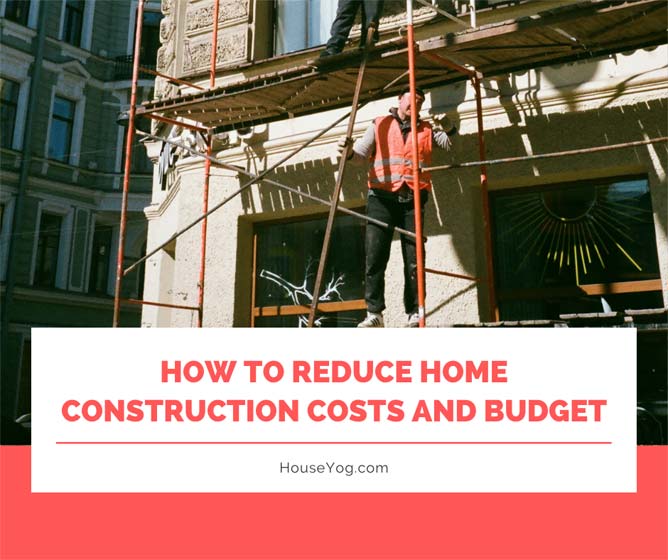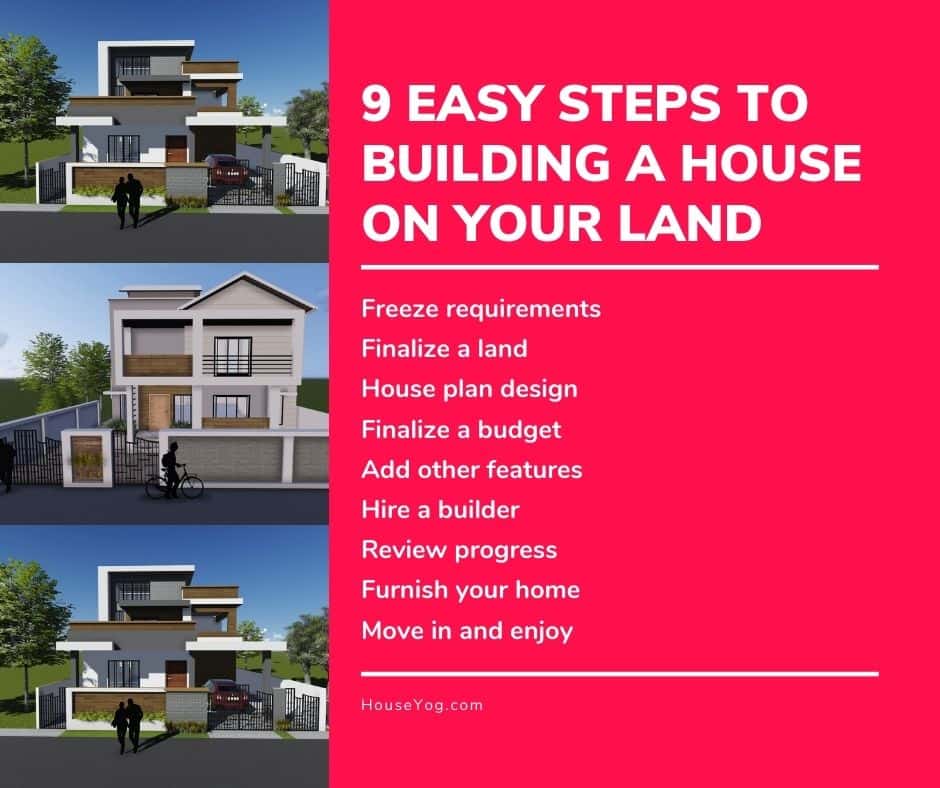Constructing a new house is a costly and time-consuming affair. It may take anywhere between 12-18 months of time, and hundreds of thousands of rupees to construct a new house on your plot. I am not even including the cost of the land, which itself may cost over a few lakhs of rupees. Needless to say, if you want to construct a new house in India, then you must think through and make a detailed home construction checklist to manage and track your project.
Managing a tracking home construction project becomes much easier when you have a detailed checklist to keep track of construction in different phases. Irrespective of whether you are building a house on your own or you are working with a single home builder, there will be certain tasks that must be tracked and managed properly.
If you are planning to construct a new house and you are looking for a construction checklist, then I have got you covered. I am sharing a detailed and the most comprehensive home construction checklist. This will help you manage everything smoothly and complete the project on time.
Home construction involved several actionable steps, such as:
- Selection of plot
- Preparing an approximate budget
- Preparing the land before construction
- House plan and building elevation design
- Hiring construction contractor
- Defining scope of work
- Finalizing construction cost and payment terms
- Documentation and plan approval
- Building materials
- Engaging subcontractors
- Supervision and updates
- Sustainable & Smart Material Choices
- Sustainability Checklist (2025)
- Smart Home Planning
- Post-Construction Handover
The home construction checklist I am sharing below can help you manage and track all of these actionable steps easily.
Downloadable Home Construction Checklist – 2025 Edition
Ultimate Home Construction Checklist: Step-by-Step Guide for 2025
Building a new home is exciting, but managing all the details — from budgeting, approvals, materials, to contractor coordination — can quickly become overwhelming. Without a structured plan, delays and cost overruns are common.
This step-by-step home construction checklist is designed to help you track every stage of your project efficiently, stay on budget, and ensure quality work. Whether you’re building on your own or with a contractor, this guide will keep you organised, reduce stress, and make sure nothing slips through the cracks.
Selection of plot
Land selection and preparation are the first step that has to be right. If you already have a plot registered in your name, then you may proceed to prepare the land.
However, if you are still searching for a plot of land to build your home, then spend some time looking for a plot that has the essential amenities like an approach road, water supply, electricity, etc. The locality is also an important factor to be considered when selecting a plot to build a new house.
Usually, land prices are higher in established localities. However, if your budget does not permit you to buy a plot closer to the city, there is no harm in moving a little away from the main city and getting a plot in a new or upcoming locality. Buying a plot of land in a gated community is also a great choice that you may like to consider.
2025 Update & Quick Checklist for Plot Selection
With rising property prices and stricter approval rules in 2025, choosing the right plot has become even more critical. Beyond location and cost, here are some factors you should verify before finalising:
- Legal verification – Check land title, mutation certificate, tax receipts, and encumbrance certificate.
- Zoning & land use – Confirm if the plot is residential and follows local building by-laws.
- Connectivity & amenities – Road access, drainage, power supply, water, and internet availability.
- Soil & terrain quality – Opt for soil testing (especially for multi-storey buildings).
- Future development plans – Check if the area is part of a master plan (upcoming metro, highways, commercial hubs).
- Community benefits – Gated societies may offer security, utilities, and resale value advantages.
Mini-Checklist:
☑ Verified ownership documents
☑ Checked land use/zoning rules
☑ Soil testing done (if required)
☑ Amenities & road access confirmed
☑ Future development plan reviewed
Pro Tip: If you’re buying land with the help of a loan, banks usually conduct their own due diligence. Still, it’s safer to get an independent legal opinion before purchase
Preparing an approximate budget
Budgeting is very important as home construction is an expensive affair. As you are already planning to construct a house, you must have a budget in mind. Consider tentative quantity and costs of major building materials like bricks, cement, sand, steel etc.
Forget about everything for the time being and look at the savings you may have. Ideally, you should start saving and getting your income and expenses balanced from early on. Even if you plan to borrow some money from your friend, or family and through a housing loan, you need to save money to build your house. You should target to save around 20-30 per cent of the overall construction budget.
If you have saved a decent amount, then that’s great; otherwise, make a quick calculation of how much it may cost to build a new house today. For the sake of calculation, you can assume the base construction price at Rs. 1100 to 1300 per sq ft of the built-up area.
So if you are planning to build a house on a 1000 sq ft house, you can safely assume it will cost around Rs. 1100000 to Rs. 1300000 using standard quality materials, floor and wall tiles, basic bathroom fittings, etc. Now you have the ballpark idea of construction cost. If you have the funds, then that’s just perfect. Otherwise, you may like to apply for a home construction loan or look for alternative ways to raise the money for construction.
2025 Update & Quick Budgeting Checklist
Construction costs have been rising steadily, and in 2025, most Indian cities are seeing Rs. 1,400–1,800 per sq. ft. for standard quality construction. Premium homes can go well above Rs. 2,200 per sq. ft. Factoring in these costs early helps avoid surprises.
Here are the key things to include when preparing your budget:
- Land-related costs – Registration fees, stamp duty, and site preparation.
- Core construction costs – Cement, steel, bricks, sand, tiles, labour charges.
- Professional fees – Architect, structural engineer, approval charges.
- Utilities & services – Electrical, plumbing, borewell, septic tank, water supply connections.
- Finishing costs – Paint, flooring, fixtures, cabinets, wardrobes.
- Contingency buffer – Always keep at least 10–15% extra for unforeseen price hikes or design changes.
- Loan planning – Compare interest rates, processing fees, and prepayment rules before finalising.
Mini-Checklist:
☑ Calculated per sq. ft. construction cost with 2025 rates
☑ Accounted for land & registration charges
☑ Included architect & approval fees
☑ Added finishing + interiors in estimate
☑ Kept 10–15% contingency buffer
☑ Checked housing loan eligibility & EMI impact
Pro Tip: Break your budget into phases (foundation, structure, finishing). This helps align payments with construction progress and makes loan disbursals smoother.
Preparing the land before construction
Now that you have a plot or land to construct a new house. The next step is to prepare the land before you can start the real construction work. Depending on the type of land, you may have to do certain preparation, like clearing the land of any disturbance. Moreover, if the land is not even, then you may have to level the land.
Another important thing to consider is to do the soil testing (Geotechnical Investigation). Especially if you are constructing a multi-storey building and you don’t know much about the history of the land. Land testing helps analyse the quality of land. It also helps design the structure of the building to sustain for a longer period of time. Moreover, soil testing also helps decide the depth of the foundation and overall building structure.
So you may like to tick it off before starting the foundation and construction work.
Land preparation is often underestimated, but skipping steps here can lead to structural issues, drainage problems, or higher costs later. In 2025, municipalities and banks are also stricter about approvals, so thorough groundwork is essential.
Here’s what to check before foundation work begins:
- Site clearance – Remove debris, vegetation, and any existing temporary structures.
- Levelling & grading – Ensure the plot is even; plan slope for proper drainage.
- Soil testing (mandatory for multi-storey) – Confirms load-bearing capacity and foundation depth.
- Boundary wall & fencing – Secures the site and prevents encroachment.
- Temporary site setup – Storage shed for materials, water supply, and electricity connection.
- Drainage & waterlogging check – Prevents foundation damage during monsoon.
Mini-Checklist:
☑ Land cleared & leveled
☑ Soil test report obtained
☑ Drainage & slope checked
☑ Boundary wall/fencing done
☑ Water & electricity arranged
☑ Temporary storage shed set up
Pro Tip: If your site is in a low-lying area, consider backfilling with quality soil or sand to raise the ground level before laying the foundation. This small step can save you from future flooding issues.
House plan and building elevation design
The next important thing to look at is to work on a house plan and building elevation design. It’s highly recommended to get a professional architect on board.
Professional architects can add real value in designing the full building plans. An architect or engineer can help design the best house plan for your new home. They can also design a building elevation that can be constructed within your budget. In fact, you can discuss your budget with them. And they can design the plan keeping your budget in mind.
Architects can also create 3D building elevation designs and perspective views as per the house plan. 3D elevation designs can give you a perspective view of the building from the outside. Building elevation designs help visualise the external view of the house from the front and other sides.
However, please be mindful of expenses when choosing the external elevation design of the building because fancy looks can easily increase the construction and finishing cost of the building. For instance, if you liked the design with exterior wall tiles, then be sure to spend more than using exterior weather-coated wall paints.
So, discuss the associated cost and your budget with the architect. And get the perspective elevation views designed before starting the construction work.
Once the house plan and perspective front elevation view of the building are ticked off, it’s time to bring the construction contractor on board.
Today, house planning is not just about room sizes and layouts—it’s about lifestyle, efficiency, and future-readiness. Here are a few things to keep in mind while finalising your plan and elevation:
Key things to check:
- Vastu compliance (optional) – Many homeowners in India still prefer Vastu-aligned designs for better harmony.
- Space utilisation – Compact yet functional layouts, like open kitchen-dining areas or multi-purpose rooms, save cost and maximise usability.
- Sustainability – Plan for natural ventilation, daylight optimisation, and rainwater harvesting to reduce long-term energy bills.
- Smart home readiness – Leave provisions for concealed wiring, solar panels, or EV charging points.
- Elevation trends – Modern facades now use stone cladding, textured paints, glass railings, and minimalist designs instead of heavy decorative elements.
- Budget-friendly choices – Instead of costly tiles on exterior walls, opt for weather-protected textured paints that provide both style and durability.
Mini-Checklist for House Plans & Elevation:
☑ Finalise floor plan with architect
☑ Discussed budget & material preferences
☑ 3D elevation views created & approved
☑ Checked for sunlight, airflow & orientation
☑ Budget impact of elevation materials reviewed
☑ Future-proofing (solar, EV, smart wiring) considered
Pro Tip: Ask your architect for at least 2–3 elevation variations (modern, traditional, minimalist) before finalising. Sometimes, a simpler design looks better and costs significantly less in finishing.
Hiring a construction contractor
Now that the house plan is ready, it’s time to look for a reliable builder or a home construction company to move forward. There should not be any shortage of local building contractors. And therefore, it’s highly recommended to talk to at least two or three construction companies available near you.
The best way to get the most accurate home construction estimate is to share your final building plan and elevation design with the builder. That way, they can see the full plan with the total built-up area to prepare a detailed bill of quantities for the construction.
However, when comparing and evaluating the offers from the builders, don’t always choose the lowest offer. Because, lowest may not be the best choice always, especially for a home construction project that can run over months. And therefore, before anything else, you should look for the credibility and quality of supplies they propose to use to construct your dream home.
How to Hire the Right Construction Contractor
Hiring a contractor is not just about finding someone to execute the drawings—it’s about finding a partner you can trust for months of work. Beyond comparing quotes, here are some modern checks:
- Background check – Look for contractors who are registered, GST-compliant, and insured. Ask for copies of licenses.
- Portfolio review – Visit at least 1–2 completed projects. Speak to past clients if possible. This will give you insight into workmanship and reliability.
- Transparency – Good contractors will provide a detailed BOQ (Bill of Quantities) instead of lump sum quotations. Avoid vague estimates.
- Payment safety – Always link payments to construction stages (foundation, plinth, slab, finishing). Never release large advance payments.
- Digital communication – Many professional contractors now share weekly progress photos/videos via WhatsApp or apps. This ensures accountability.
- Contract clauses – Include penalties for delays, specifications of materials (cement, steel, tiles), and a warranty for basic structural work.
Mini-Checklist for Contractor Hiring:
☑ Compared at least 2–3 contractors’ detailed quotes
☑ Verified past projects & client references
☑ Checked GST registration & insurance
☑ Written agreement prepared (not verbal)
☑ Payment tied to construction milestones
☑ Clarified penalty clauses & warranty terms
Pro Tip: Don’t let emotions drive your choice. A slightly higher quote from a professional, transparent builder often saves you time, money, and stress compared to the cheapest option.
Defining the scope of work
Most of the builders and construction companies offer end-to-end construction service, which may include everything from the planning stage to finishing or semi-finished construction. And therefore, it is important to clearly define the scope of work before signing the deal.
Work with the contractor to define the specification of every item as per the bill of quantities they might have generated.
Clearly define the scope of work and work with the total cost, including materials and labour charges. If the builder is providing all the materials and labour, then discuss the brands and price range for each of the items, like cement & steel.
Why Scope of Work Matters More Than Ever
A well-defined Scope of Work (SoW) is the foundation of a smooth home construction journey. Ambiguity here is one of the top reasons for disputes, cost escalations, and delays.
Here’s what you should include in your SoW:
- Stage-wise deliverables – Break down the work into stages (foundation, structure, plastering, flooring, finishing) with clear timelines.
- Material specifications – Clearly mention brand, grade, and quantity ranges for items like cement (53 grade OPC/PPC), TMT steel (Fe500/550), tiles, bathroom fittings, electrical wires, etc.
- Inclusions & exclusions – Mention what the contractor is responsible for (labour, shuttering, scaffolding, site cleaning) and what is not included (interior finishing, furniture, landscaping, appliances).
- Quality benchmarks – Define testing requirements for critical materials like concrete, steel, and bricks.
- Change order policy – Homeowners often make changes mid-way (extra bathroom, bigger balcony, higher-grade tiles). Define how such changes will be priced and documented.
- Timeline & penalties – Agree on deadlines for each stage and a penalty clause for unreasonable delays.
Mini-Checklist for Scope of Work:
☑ Written document listing all deliverables & exclusions
☑ Brand and quality of materials clearly specified
☑ Stage-wise construction timeline included
☑ Payment terms tied to milestones (not verbal promises)
☑ Change order procedure documented
☑ Penalty clause for delays agreed upon
Pro Tip: Always ask for the Bill of Quantities (BOQ) to be signed by both you and the contractor. It becomes the reference point for disputes and ensures everyone is on the same page.
Finalising construction cost and payment terms
Home construction costs can easily run into hundreds of thousands of rupees, depending on the size of the house and the quality of construction you want. And therefore, construction cost and payment terms must be discussed with the builder and defined in the contract.
Moreover, you discuss the total cost including the cost of the materials, labour charges and any other charges that may arise due to some reason like price rise. For instance, the price of a bag of cement today may increase after three months. And therefore, it is important to discuss and sort such issues well in advance to avoid any future price disputes and surprises.
The payments to the contractor can be linked with the progress of construction work. That means you will pay as they progress with the construction. However, some developers and builders may ask for a percentage as an advance and then the rest of the payment as per the progress.
Whatever the case, make sure to define the total cost (including taxes) and payment terms well in advance before signing the contract.
Finalising Cost & Payments Without Disputes
Today, construction costs are rising faster due to fluctuating cement, steel, and labour prices. To stay safe:
- Escalation clause – Agree on how price hikes will be handled (builder absorbs vs. cost shared).
- Retention money – Keep 3–5% of the total contract value to be released only after the defect liability period (usually 3–6 months).
- Digital tracking – Use spreadsheets or apps to track stage-wise payments against milestones.
- GST & receipts – Ensure every payment is invoiced properly to avoid legal/tax complications later.
- No big advances – Limit advance to 5–10%. Rest should be tied to progress.
Cost & Payment Checklist:
☑ Itemised quotation signed by both parties
☑ Escalation clause written in contract
☑ Retention money agreed (3–5%)
☑ Stage-wise payments linked to milestones
☑ GST invoices & receipts collected
Pro Tip: Don’t release final payment until you receive a completion certificate, NOCs (if applicable), and defect rectification assurance.
Documentation and plan approval
The developer or architect can easily get the plan approved from the local building authorities. However, the house plan must be designed according to the prescribed local building guidelines. Otherwise, you may have difficulties in getting the house plan approved.
So, you should talk to the architect or the builder to get this right in the first place.
Moreover, if you plan to get a home construction loan, then you have to get the documentation right. Banks will require a different set of documents to process your construction loan. Primarily, the bank wants to ensure that you have a freehold land registered in your name. And therefore, they need the deed, mutation certificate, tax receipts, etc. They’ll also ask for a building plan and bill of quantities with projected construction estimates to process your loan application.
Home loan processing and approval can easily take a few weeks. Therefore, if you plan to avail a home loan, then spend time getting the documentation right.
Documentation is no longer just about plan approval — it also plays a role in home loan approvals, insurance, and resale value.
Key documents required:
- Land documents – Sale deed, mutation certificate, property tax receipts, encumbrance certificate (to prove clear title).
- Building plan approval – Must comply with municipal building codes, height restrictions, and FAR (Floor Area Ratio) norms.
- Environmental & safety clearances (for larger plots) – Sometimes required in urban/semi-urban areas.
- Bank loan requirements – BOQ, construction estimate, sanctioned building plan, and sometimes soil test reports.
- Contract agreement – A registered contract between you and the builder strengthens loan approval and avoids disputes.
Documentation Checklist:
☑ Freehold land papers in your name
☑ Mutation, tax receipts, encumbrance certificate ready
☑ Sanctioned building plan as per local authority rules
☑ BOQ + cost estimate prepared for bank
☑ All agreements in writing (contractor + architect)
Pro Tip: Always keep two sets of documents — one physical file and one digitally scanned backup in Google Drive or Dropbox for easy access during loan processing or approval checks.
Building materials
The quality of materials you are using in the construction can directly affect the strength of the building. The builder has most likely provided you with the specifications of the materials they will use. Therefore, you have to ensure that the materials being used in the construction are as per the specification.
However, there may be a situation where a particular material specified in the contract is out of stock. Or it may be simply unavailable due to high demand. In such cases, the alternate material being used must be of similar quality and standard.
Choosing the Right Building Materials in 2025
The cost and longevity of your home depend largely on the materials used at each stage of construction. Here’s what to keep in mind:
- Cement – Use ISI-certified OPC 53 Grade or PPC cement. Store bags in a dry, elevated place to avoid moisture damage.
- Steel – Opt for TMT bars of Fe500/550 grade. Ask for test certificates to ensure strength and flexibility.
- Bricks/Blocks – Compare traditional clay bricks, fly ash bricks, and AAC blocks. AAC blocks are lightweight and provide better insulation but cost slightly more.
- Sand & Aggregates – Use river sand or M-sand (manufactured sand) from certified suppliers. Avoid untested local sand that may weaken the structure.
- Concrete – For major structural work, ready-mix concrete (RMC) ensures better quality control compared to on-site mixing.
- Plumbing & Electrical – Never compromise on pipes and wires. Use CPVC/PPR pipes for plumbing and ISI-certified fire-resistant wires.
Sustainable & Smart Material Choices
Modern homeowners are increasingly choosing eco-friendly and energy-efficient materials:
- Low-VOC paints – Safer for health and the environment.
- UPVC windows – Energy-efficient and durable compared to wood or aluminium.
- Solar roofing tiles & reflective paints – Reduce electricity costs.
- Fly ash bricks/AAC blocks – Lower carbon footprint and better thermal insulation.
Material Procurement Checklist
☑ All materials ISI/BIS certified
☑ Test certificates for cement, steel, and RMC collected
☑ Alternative materials pre-approved in contract
☑ Storage conditions checked (covered, moisture-free, ventilated)
☑ Sustainable options considered (AAC blocks, solar tiles, low-VOC paints)
Pro Tip: Always insist on a Material Inspection Register at the site. Before unloading, check brand, batch number, and expiry date (especially for cement, waterproofing chemicals, and paints).
Engaging subcontractors
Mostly, the developer and construction companies have their own set of subcontractors. However, in some cases, they tend to employ other subcontractors for different work, like flooring or plastering, etc. However, the subcontractors should be skilled, experienced and capable of delivering the best finished work.
Secondly, if you want your own subcontractor for a specific job like plumbing or electrical work, then you must discuss the same with the builder in advance. and get the prices adjusted accordingly. Sometimes it’s better to use local resources, especially for tasks that may require understanding and future support, like electrical wiring or plumbing lines.
Managing Subcontractors Effectively
Subcontractors play a critical role in specialised jobs like plumbing, electrical, flooring, painting, and waterproofing. Even if your main contractor handles everything, proper engagement and oversight can prevent delays, poor finishes, or warranty issues.
Here’s what to keep in mind:
- Skill verification – Always check experience, past projects, and references before engaging any subcontractor.
- Written agreement – Include scope, timelines, quality expectations, and payment terms for subcontractors.
- Integration with main contractor – Ensure your subcontractor coordinates with the main builder to avoid schedule conflicts.
- Local support advantage – For jobs that may need future maintenance (like electrical or plumbing), local subcontractors can provide quicker post-construction support.
- Payment milestones – Link payments to completion of work stage rather than time spent, ensuring accountability.
- Digital tracking – Use WhatsApp or construction apps to get weekly progress photos and updates, even for subcontractors.
Subcontractor Checklist
☑ Verified skills and references
☑ Scope, timelines, and quality expectations documented
☑ Coordinated with the main contractor’s schedule
☑ Payment linked to milestone completion
☑ Post-construction support clarified (especially plumbing/electrical)
☑ Weekly progress tracked digitally
Pro Tip: Even if your contractor recommends subcontractors, inspect their previous work before giving final approval. A small time investment here saves big headaches later.
Supervision and updates
It is seriously important to supervise the construction work and get periodic updates about the progress from the builder. You should make a few surprise visits to the construction site to oversee the work. This will help you get a clear picture of the construction work.
Moreover, if you have taken a construction loan, then the bank will release funds after reviewing the progress of the work. And therefore, it is super important to constantly monitor the progress of the construction work.
How to Supervise Construction Effectively
Supervision is more than just visiting the site — it’s about proactive management, tracking quality, and ensuring timelines are met. Here’s how to do it efficiently:
- Digital progress tracking – Use apps, WhatsApp, or spreadsheets to get weekly photos, videos, and updates on milestones.
- Surprise site visits – Periodically check the construction site without prior notice to verify work quality and adherence to the plan.
- Daily/weekly logs – Maintain a small log noting materials received, work completed, and any deviations from the plan.
- Bank inspection coordination – If you have a construction loan, align site visits with the bank’s fund release schedule.
- Quality checkpoints – Inspect concrete curing, steel placement, waterproofing, plastering, and tile work before the next stage begins.
- Communication protocol – Keep a single point of contact with the builder/contractor to avoid mixed messages.
Supervision Checklist
☑ Weekly updates via photos/videos
☑ Surprise site visits conducted
☑ Work progress logged in writing or digitally
☑ Bank inspection aligned with fund release
☑ Key quality checks at each stage
☑ Clear communication channel with contractor
Pro Tip: Even if your contractor is experienced, your involvement ensures accountability. A little supervision now prevents costly mistakes and delays later.
Sustainability Checklist (2025)
Sustainable construction is no longer optional — it’s a smart choice for cost savings, environmental responsibility, and long-term comfort. Consider integrating these features into your new home:
- Rainwater harvesting – Install tanks and plumbing for collecting and reusing rainwater. This reduces dependence on municipal water and helps in water conservation.
- Solar panel readiness – Plan roof structure, wiring, and orientation to accommodate solar panels in the future.
- Energy-efficient lighting & insulation – Use LED lights, energy-efficient windows, and proper wall/roof insulation to reduce electricity consumption.
Mini Sustainability Checklist:
☑ Rainwater harvesting infrastructure in place
☑ Solar panel-ready roof & wiring
☑ LED and energy-efficient lighting installed
☑ Proper insulation for walls and roof
Pro Tip: Planning these features during construction is cheaper and more effective than retrofitting later.
Smart Home Planning
Homes are getting smarter! Planning for IoT and smart devices during construction ensures a modern, connected lifestyle without expensive rewiring later.
- IoT wiring & smart switches – Lay conduits and wiring for smart lighting, fans, and appliances.
- Security system provision – Pre-plan CCTV, motion sensors, and door access control wiring.
- EV charging point – Allocate space and power lines for future electric vehicle charging.
Smart Home Checklist:
☑ Conduits for IoT & smart switches installed
☑ Security system wiring pre-planned
☑ EV charging point ready with dedicated circuit
Pro Tip: Even if you don’t use all smart features immediately, pre-installation saves major renovation costs later.
Post-Construction Handover
The final stage of construction is as critical as the building process itself. Proper handover ensures a smooth move-in and protects your investment.
- Final snag list correction – Inspect the property carefully for unfinished work, leaks, or defects, and get them corrected.
- Collect warranties & manuals – Gather documents for appliances, HVAC, plumbing, and electrical installations.
- Apply for an occupancy certificate (OC) – Submit approved building plans and get legal permission to occupy the house.
Handover Checklist:
☑ Snag list completed & corrected
☑ All warranties & manuals collected
☑ Occupancy certificate applied for / received
☑ Final payment released only after handover
Pro Tip: Keep photographic documentation of all defects and corrections. It helps during warranty claims and future resale.
Downloadable Home Construction Checklist – 2025 Edition
This comprehensive checklist helps you manage every phase of building your dream home in India. From selecting the plot to post-construction handover, ensure nothing is overlooked.
Final thoughts on the construction checklist
Managing and keeping track of different aspects of constructing a new house can be overwhelming. Especially so, because it involves several tasks, e.g. documentation, plan approvals, budgeting, etc. It’s not going to be easy to keep track of contractors, raw materials and construction without a checklist.
However, you can easily manage and keep track of everything using a construction checklist. A detailed construction checklist like that will help you track and manage everything much efficiently.
What else do you think one should add to the home construction checklist to make it more effective?
Share your tricks and hacks by commenting below!
Happy home construction!






